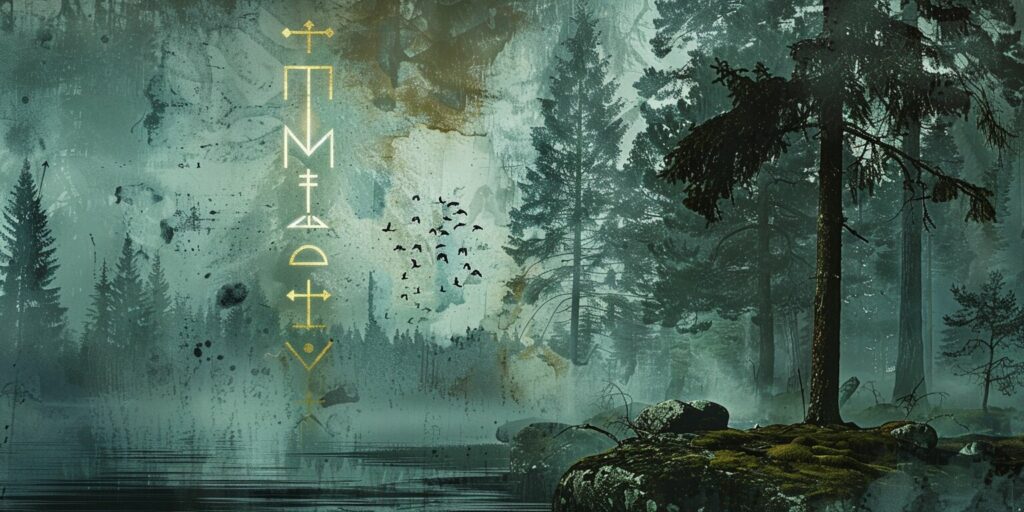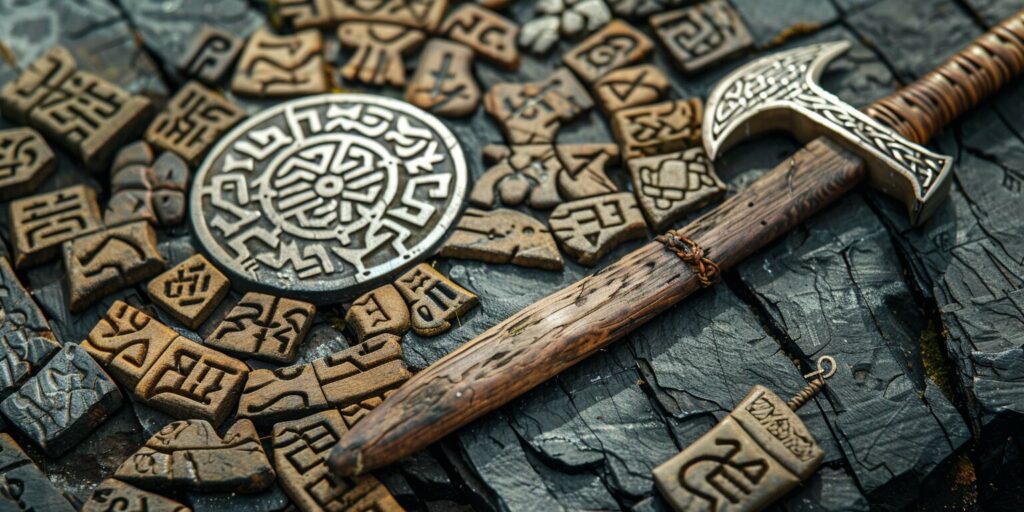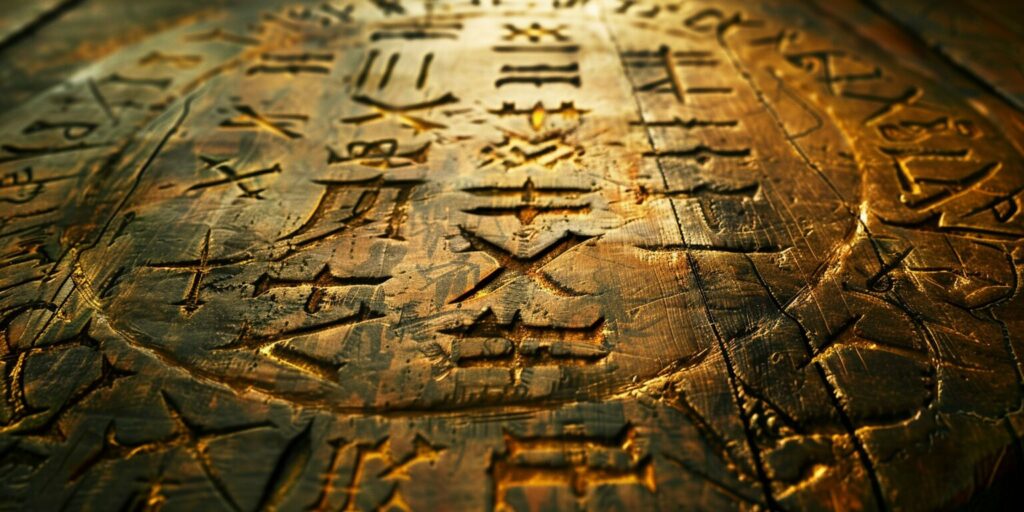Norse Runes, Norse Symbols, Vikings
The Art of Viking Runes: A Guide to Ancient Norse Alphabets
Welcome to the fascinating world of Viking runes, where we explore the ancient Norse alphabet’s history, significance, and artistic value. The Viking alphabet, also known as the runic script, holds secrets and mysteries that have captivated historians, language enthusiasts, and art lovers alike.
The Viking rune alphabet is a unique system of symbols that was used by the Vikings to write in their native language. It is a window into the past, allowing us to understand the culture and beliefs of these ancient seafarers. Each rune in the Viking alphabet holds its own meaning and symbolism, representing concepts such as strength, protection, and wisdom. These symbols were used for writing, divination, magic, and even as decorative motifs on everyday objects.
Whether you are fascinated by Viking history and ancient languages or simply appreciate the beauty of ancient scripts, the study of Viking runes offers a captivating exploration into the world of the Norse writing system. Let’s embark on this adventure together and unlock the hidden artistry of the Viking rune alphabet.
Unveiling the Secrets of the Viking Alphabet
In this section, we will examine the Viking alphabet, also known as the runic script. The Viking runes alphabet was a writing system used by ancient Norse culture. These mysterious symbols hold a deep historical and cultural significance.
The origins of the Viking rune alphabet can be traced back to the 2nd century AD. The Vikings used these unique symbols for various purposes, including communication, divination, and magical practices. Each rune in the runic alphabet had a specific meaning and was associated with a particular sound or concept.
The Different Runic Alphabets
The Viking runes alphabet consisted of several different runic scripts, each with its own variations. The most commonly known runic alphabet is the Elder Futhark, which has 24 characters. Another popular runic script is the Younger Futhark, which had fewer characters and was used primarily for writing Old Norse.
Each runic symbol had a phonetic value and a deeper symbolic meaning. The Vikings believed that these symbols possessed magical properties and could channel specific energies or invoke certain deities. The runic alphabet was integral to their daily life, from inscribing personal belongings to carving memorial stones.
The Meanings Behind the Runes
Each rune in the Viking alphabet had a distinct name and was associated with a particular concept or deity. For example, the rune “Fehu” represented wealth and abundance, while “Uruz” symbolized strength and perseverance. The meanings associated with the runes reflected the values and beliefs of the Norse culture.
- Fehu: Wealth, abundance
- Uruz: Strength, stamina
- Thurisaz: Protection, defense
- Ansuz: Inspiration, communication
- Raidho: Journey, travel
The Viking alphabet was a written language and a sacred tool for casting spells, seeking guidance, and connecting with the spiritual realm. The runes were often carved onto objects, used in rituals, or inscribed as magical charms.
In the next section, we will delve deeper into the intricacies of old Norse runes and explore their unique features and symbolism.
Understanding Old Norse Runes
In this section, we will delve deeper into the intricacies of old Norse runes and the ancient writing system used by the Vikings. These unique symbols hold profound meaning and were integral to the Norse alphabet. Let’s explore the symbolism and significance behind each rune and how the Vikings used them to communicate, cast spells, and leave their mark on objects.

Symbolism of Old Norse Runes
Each Old Norse rune carries its own distinct symbolism and significance. In Norse mythology, the runes were not merely an alphabet but also represented concepts, forces of nature, and even deities.
- Fehu: Representing wealth and abundance, Fehu was a rune associated with material prosperity and success.
- Uruz: Uruz symbolized physical strength and power, often associated with courage and vitality.
- Ansuz: Ansuz represented divine inspiration, wisdom, and communication.
- Raido: The rune Raido signified journeys, both physical and spiritual, and symbolized travel, movement, and change.
- Kenaz: Kenaz embodied knowledge and enlightenment, representing intellectual pursuits and creative energy.
- Gebo: Gebo symbolized the concept of reciprocity and the giving and receiving of gifts or favors.
Viking Uses of Runes
The Vikings used runes for various purposes, encompassing both practical and mystical applications.
- The runic script was commonly used in inscriptions on objects like weapons, tools, and personal belongings to identify the owner or convey a message.
- Runic inscriptions were also used in magical practices, such as casting spells, protection, or invoking the favor of gods and spirits.
- Runestones, large stones with runic inscriptions erected as monuments or commemorations, were prevalent throughout Viking territories.
Unlock the secrets of these ancient Norse alphabet symbols and gain insight into the Vikings’ rich cultural heritage. Understanding old Norse runes allows us to uncover their historical significance and appreciate the artistry and symbolism of this remarkable ancient writing system.
Decoding the Viking Language Symbols
In this section, we will explore the fascinating relationship between Viking runes and the Norse language. The runic script played a key role in writing different dialects of the Scandinavian languages and is highly significant in understanding ancient Norse culture.
The Pronunciation of Runic Symbols
Each runic symbol in the Viking language represents a specific sound or phoneme. Understanding the pronunciation of these symbols is crucial in decoding the meaning behind Viking inscriptions. For instance, the runic symbol ‘ᚦ’ (pronounced ‘th’) represents the “th” sound in words like “this” and “that”.
Examples of Viking Inscriptions
One of the best ways to gain insight into the Viking language symbols is by exploring actual examples of Viking inscriptions. These inscriptions were commonly found on objects such as stones, weapons, and personal belongings. The runic symbols etched onto these artifacts provide a glimpse into the Vikings’ daily lives, beliefs, and culture.
- Runestone Inscriptions: Runestones are large stones carved with runic inscriptions that served as memorials or markers. The inscriptions usually contained information about historical events, voyages, or commemorative messages.
- Weapon Inscriptions: Viking weapons often bore runic inscriptions, which were believed to provide protection or enhance the weapon’s power. These inscriptions can reveal the names of the weapons’ owners, mythical references, or even poetic phrases.
- Amulet Inscriptions: Runes were commonly used on amulets for protective purposes. Amulets with runic inscriptions were believed to bring luck, ward off evil spirits, and ensure the wearer’s safety.
By examining these examples, we can better understand the Viking language symbols and their significance in Norse society.
Tracing the Ancient Nordic Script
In this section, we will embark on a journey to trace the origins of the ancient Nordic script, a writing system used by the Vikings. By exploring the historical context and cultural influences surrounding the development of this script, we gain valuable insights into the rich tapestry of Viking culture and civilization.
The ancient Nordic script, commonly known as the Viking runes, played a vital role in communicating ideas, beliefs, and stories among the Norse people. These intricate symbols were far more than just a means of writing; they were a profound expression of the Viking way of life.
It is important to note that the Viking runes are distinct from other ancient scripts, such as the Elder Futhark. While both scripts belong to the Runic family, the ancient Nordic script emerged as a result of unique cultural influences and historical developments that shaped the Vikings’ distinctive writing system.
To truly understand the ancient Nordic script, we must analyze its form, structure, and usage differences. With their angled shapes and simple yet powerful strokes, the Viking runes reflect aspects of the Viking spirit, expressing a sense of strength and resilience.
Throughout this section, we will unravel the mysteries of the ancient Nordic script by examining examples of runic inscriptions found on various artifacts. By deciphering these enigmatic symbols, we will gain a glimpse into the Vikings’ stories, beliefs, and aspirations.
Exploring the Differences: Viking Runes vs. Other Ancient Scripts
- The ancient Nordic script evolved from earlier runic alphabets like the Elder Futhark but developed its own distinct set of symbols and phonetic values.
- Unlike other ancient scripts, which primarily served as a recording system, the Viking runes had both practical and mystical significance within Norse culture.
- The unique angular shapes of the Viking runes set them apart from the curvilinear nature of scripts like the Elder Futhark.
- Viking runes were often used for magical purposes, such as casting spells, while other ancient scripts had different functions in their respective cultures.
Examining these differences gives us a deeper appreciation for the ancient Nordic script and its importance within Viking society. Join us on this exploration as we uncover the fascinating world of the Viking runes and the cultural significance embedded within their intricate designs.
Exploring the Runes of the Vikings
Welcome to the fascinating world of Viking runic inscriptions! In this section, we will take you on a journey through time as we explore specific examples of these ancient runes.
Throughout history, the Vikings left their mark on various objects and artifacts with their intricate and mystical runic script. From weapons to tools and even amulets, these objects bear the secrets of the Viking culture.

Objects Bearing Viking Runes
- Ancient Weapons: Swords, axes, and shields adorned with Runic inscriptions are impressive in craftsmanship and tell stories of battles fought and legends forged.
- Tools and Implements: Everyday objects used by the Vikings, such as farming tools, display the practical application of the runic script and offer glimpses into their daily lives.
- Amulets and Personal Items: Runes were often used on amulets to bring luck or offer protection. Personal items inscribed with runes provided a sense of identity and connection to the spiritual realm.
Each runic inscription has a unique meaning and message, offering insights into the beliefs, history, and culture of the Vikings. By decoding these ancient symbols, we can shed light on the cultural significance of the runic script.
Deciphering the Meanings and Messages
While the exact interpretation of some runic inscriptions may still be debated among scholars, many carry common themes and symbolism that reflect the Viking worldview. Themes such as bravery, power, protection, and even magical spells can be found in these ancient messages.
By closely examining the runes of the Vikings, we can gain a deeper understanding of their values, mythology, and the motivations that shaped their society.
Take this opportunity to delve into the world of Viking runic inscriptions and unlock the hidden meanings and messages behind these ancient symbols.
Conclusion
In this concluding section, we have explored the fascinating world of the Viking alphabet and ancient Norse runes. The viking alphabet, also known as the Runic script, was a unique writing system used by the Vikings to communicate, document their history, and express their beliefs. These viking language symbols, known as runes, have captured the imagination of scholars, historians, and enthusiasts alike.
By examining the ancient Nordic script and decoding the runes of the Vikings, we have gained insights into the cultural and linguistic importance of the Viking rune alphabet. The significance of each Norse alphabet symbol goes beyond its physical form; it carries the weight of centuries of history, mythology, and storytelling.
Whether you are interested in viking history, ancient languages, or art, the study of the Viking runes offers a captivating journey into the past. By exploring the old Norse runes and their meanings, one can unlock the mysteries of the viking alphabet and gain a deeper understanding of the viking culture and their written legacy. So take a step back in time, embrace the ancient Nordic script, and let the runes of the Vikings guide you through their rich and captivating world.

